![]()
![]()
![]()
Use LEFT and RIGHT arrow keys to navigate between flashcards;
Use UP and DOWN arrow keys to flip the card;
H to show hint;
A reads text to speech;
28 Cards in this Set
- Front
- Back
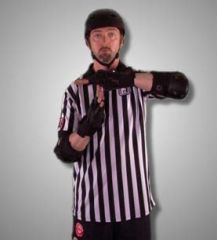
|
TEAM TIMEOUT
This hand signal is used by team captains and designated alternates to request a team time out (2.6.5) or to request and Official Review (9.2.11). A “T” is made with both hands held perpendicular and with palms open. |
|
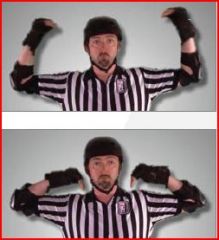
|
OFFICIAL TIMEOUT
The fingertips of both hands touch the top of their respective shoulder. |
|
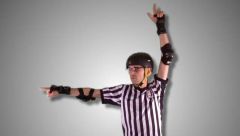
|
LEAD JAMMER
The right arm is extended with the index finger pointing towards the Lead Jammer, while the left arm is held straight up in the air with the hand making an “L” shape with the index finger and the thumb. This is held until the Jammer reaches the Engagement Zone in the first scoring pass. The left arm is then dropped. Throughout the duration that the Jammer retains Lead Jammer status, the right arm remains extended with the index finger pointing towards the Lead Jammer. |
|

|
NOT LEAD JAMMER
Arms are held nearly perpendicular to the floor in front of the body and waved back and forth so that they cross in the center of the body. This is repeated until the Jammer reaches the Engagement Zone on the first scoring pass. |
|
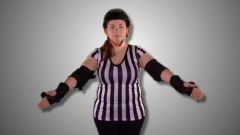
|
PACK IS HERE
Both arms are extended with palms open and facing inward. The forward palm should indicate the front of the pack, while the back palm indicates the back of the pack. |
|
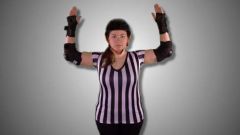
|
NO PACK
Both arms are raised, elbows bent, so that the forearms are vertical with palms open and facing one another. |
|

|
BLOCKING TO THE BACK
Arms are initially forward and bent at a 90-degree angle. They are then extended forward until straight out in front of the body. |
|
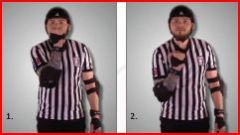
|
BLOCKING TO THE HEAD / HIGH BLOCKING
The right forearm is placed in front of the body, palm towards the inside, with the hand closed in a fist in front of the chin. The forearm is then moved down, bringing the fist close to the chest. |
|
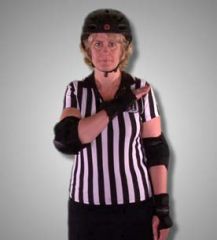
|
LOW BLOCKING
The right arm is forward across the body and bent at the elbow. The right hand contacts the body just below the left shoulder. |
|

|
USE OF ELBOWS
The arm is bent at the elbow, with the elbow pointing forward. The hand contacts the elbow. |
|
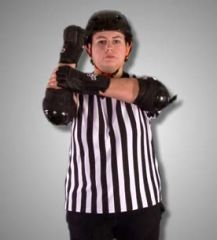
|
USE OF FOREARMS AND HANDS
The arm is bent at the elbow, with the elbow pointing forward. The hand contacts the forearm. |
|
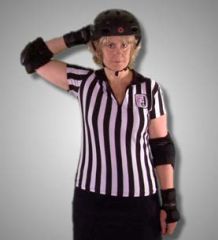
|
BLOCKING WITH THE HEAD
The right hand is held against the back of the helmet, palm open towards the helmet, with the bent elbow held out to the side. |
|
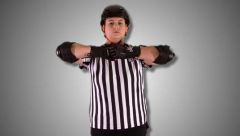
|
MULTIPLAYER BLOCKING
Fingers of both hands are clasped with forearms held out perpendicular to the body. |
|
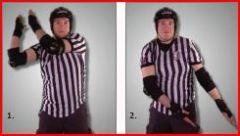
|
OUT OF BOUNDS BLOCKING
Hands are held parallel over the shoulder and moved across the body to the opposite hip. |
|

|
DIRECTION OF GAME PLAY
The right arm is held out, forearm extended, palm up. The elbow remains stationary while the forearm rotates a full 180 degrees back and forth. |
|
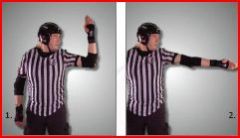
|
OUT OF PLAY
The arm is held out with the elbow bent at a 90 degree angle. This is a visual warning given when a skater or skaters are out of play. When a penalty is committed, the arm is dropped in a chopping motion. This chop is done once per penalty. |
|
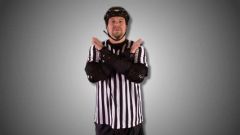
|
CUTTING THE TRACK
Arms are held out with the forearms crossed in front of the body. |
|
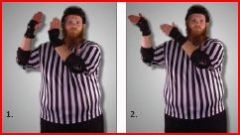
|
SKATING OUT OF BOUNDS
Hands are held parallel to one another, near the head, and towards the side of the track where the infraction occurred, with fingers facing upward. Wrists are then bent toward the side of the track where the infraction occurred. |
|

|
ILLEGAL PROCEDURE
Fists are held out in front of the chest with forearms perpendicular to the body and moved together in a circular motion. |
|
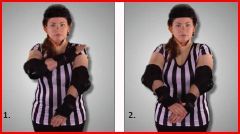
|
INSUBORDINATION
The left arm is held out straight, aimed at the floor at an angle. The right hand is made into a flat palm with all fingers extended and placed on the left shoulder, then the right hand is brushed down to the left hand. |
|

|
DELAY OF GAME
The left hand is extended in front of the body, parallel to the floor and perpendicular to the torso. The palm is facing up, fingers together. The right hand is extended in front of the body, perpendicular to the left hand, and parallel to the body at shoulder height. The right hand is moved downward in a chopping motion to contact the left hand. |
|

|
MISCONDUCT
A hand is placed to the opposite shoulder of the arm used, just below the clavicle, palm to chest. The hand is swept across the chest to the shoulder of the arm used. |
|

|
GROSS MISCONDUCT
A hand is placed to the opposite shoulder of the arm used, just below the clavicle, palm to chest. The hand is swept across the chest to the shoulder of the arm used. After completing the signal for Misconduct (6.16) the right arm is extended. The elbow is bent and the hand is moved up with the thumb pointing toward the shoulder. This penalty is only issued by the crew head referee. |
|
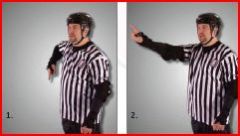
|
MAJOR
The right arm is extended. The elbow is bent and the hand is moved up with the thumb pointing toward the shoulder. This penalty is only issued by the crew head referee. |
|
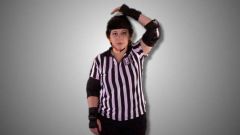
|
JAMMER LAP POINT
A tapping on the helmet with the palm, done by the Jammer Referee whose Jammer is being lapped, as the other Jammer Referee passes them on the infield. The sound of the wrist guard on the helmet may also alert the other Jammer Referee to the potential point scoring opportunity. This is not a signal that the Jammer has scored, but is communication from one referee to another that the jammer is eligible to score. |
|
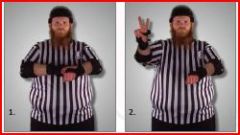
|
ADDITIONAL PENALTY BOX TIME
This signal indicates to a penalty box official that a skater must serve more than one minute. The left arm is held out in a fist, palm down, in front of the torso. Two fingers are extended from the right hand and tapped twice on the left wrist. The number of minutes the skater must serve is then shown with the right hand. The fingers are once again tapped twice on the left wrist. |
|
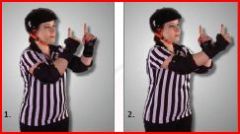
|
NO PASS NO PENALTY
This signal indicates that a skater has moved in front of another skater or skaters in an action that is not illegal, but without completing a scoring pass. The left fist is held in front of the chest, and the right fist is placed between the left fist and the chest. The index on both hands is pointing up. The right hand then moves in front of the left hand by executing a half-circle that’s on a plane parallel to the ground. |
|

|
RETURN TO THE TRACK / RETURN TO YOUR BENCH
These signals are interchangeable depending on the position of the official (inside the track boundary or outside the track boundary) and may be made with either hand depending on the official’s location. They are used to instruct skaters to remain on the track or to return to the team bench area. RETURN TO THE TRACK The arm is extended in front of the chest with the elbow bent slightly; fingers extended and palm facing the body. Bending at the elbow, the hand is waved toward the body. RETURN TO YOUR BENCH The arm is held perpendicular to the body with the palm open and facing outward. The elbow is then straightened and the arm is extended away from the body. |

